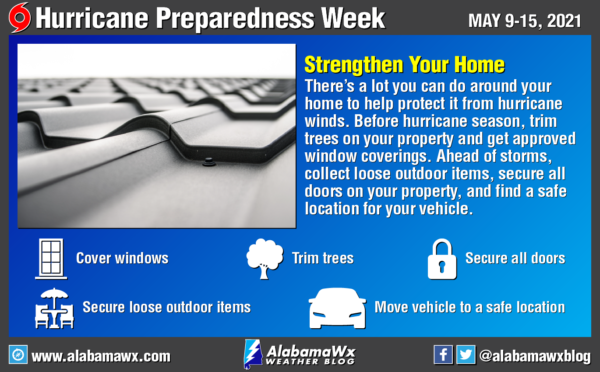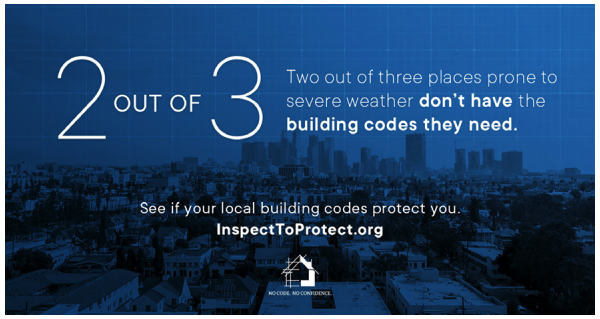Hurricane Preparedness Week – Day 5: Strengthen Your Home
Preparing your home for hurricanes can mean the difference between minor damage and complete destruction. Strengthening your home to withstand high winds can be as easy as the ABCs.
Anchor
• Bring anything from the yard that could become windborne inside and ask neighbors to do the same.
• Replace gravel/rock-landscaping material with fire treated, shredded bark, or other lightweight mulch to eliminate the potential for windborne missiles.
• Trim and anchor down trees and foliage.
• Strengthen your soffits by applying a bead of polyurethane sealant between the wall and the trim into which the soffit panels are inserted.
• Secure an inspection to make sure your home has wall-to-foundation (anchor bolts/rebar) connections.
Brace
• Bolt all doors with foot and head bolts with a minimum one-inch bolt throw length.
• Reinforce the garage door and tracks.
• Brace all gable end walls with horizontal and/or diagonal braces.
Cover
• Cover all large windows and doors, especially patio doors with securely fastened, tested, and approved impact-resistant shutters with proper mounting hardware, or replace them with impact-resistant, window and door systems if feasible.
• Make sure all doors and windows are properly caulked and/or weather-stripped to reduce potential water intrusion.
• Install a roof covering that is rated for high wind and impact from hail or debris.
Strap
• Tie down any free-standing fixtures in your yard.
• Fasten rafters/trusses to walls with hurricane straps/clips
In addition to flood insurance, there are many steps you can take to minimize flood damage, including elevating electrical outlets, anchoring fuel tanks, installing a floating drain, and elevating appliances inside and outside.
Keep your gutters and downspouts clear of debris, so they can carry rainfall and storm water away from your foundation. If flooding is imminent, you should secure sandbags. If they are properly filled, placed, and maintained, sandbags can redirect storm water and debris flows away from a home and other structures.
If you have a generator, don’t forget these helpful safety tips:
• Always operate the generator outdoors and away from open windows and doors — NEVER operate it inside, including the basement, enclosed patio, or garage. Year after year, carbon monoxide poisoning from unsafe generator use kills people, even wiping out entire families. Generators can easily be used safely, and these deaths are completely preventable.
• Understand the primary hazards to avoid when using a generator—carbon monoxide (CO) poisoning from the toxic engine exhaust, electric shock/electrocution, and fire.
• Always follow manufacturers directions supplied with the generator.
• Keep the generator dry to avoid electrocution.
• Never try to power the house wiring by plugging the generator into a wall outlet. Known as “backfeeding,” this practice puts utility workers, your neighbors and your household at risk of electrocution.
• Be sure to turn the generator off and let it cool down before refueling. Gasoline spilled on hot engine parts could ignite.
• Store fuel for the generator in an approved safety can. Use the type of fuel recommended in the instructions or on the label on the generator.
• Ask your local fire department if local laws restrict the amount of fuel you may store at your location. Store the fuel outside of living areas in a locked shed or other protected area. To guard against accidental fire, do not store it near a fuel-burning appliance, such as a natural gas water heater in a garage.
• Plug appliances directly into the generator, or use a heavy duty, outdoor-rated extension cord that is rated (in watts or amps) at least equal to the sum of the connected appliance loads. Check that the entire cord is free of cuts or tears and that the plug has all three prongs, especially a grounding pin.
• Before the start of hurricane season, be sure to start your generator to ensure that it is fully operational after being stored.
Are You Code Confident?
Modern building codes ensure that your home is built using the latest practices and standards to protect against disasters like floods and hurricane winds. But what if your home is older, and you don’t know what codes your builder followed?
According to Federal Alliance for Safe Homes research, eight of ten Americans are not worried about codes as they believe that they already have what they need to be safe. However, only one-third of U.S. communities have the codes necessary to meet Mother Nature’s wrath.
You can find what you need to know about the building codes used where you live at the newly expanded www.Inspect2Protect.org website. The site offers current and historic code information, disaster history for your community, upgrades to make your home #HurricaneStrong, and insights on future risk from all types of weather.
Helpful Links
• FLASH: How-To Videos
• Protect Your Home From Flooding video (English/https://www.youtube.com/watch?v=pQ8nI-Qn_Ew)
All information from: NOAA, FEMA, FLASH, The Red Cross, Alabama EMA.
Category: Alabama's Weather, ALL POSTS, Met 101/Weather History, Severe Weather, Tropical

















